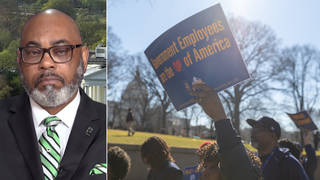
Topics
Guests
- Josh ZinnerCo-director of Neighborhood Economic Development Advocacy Project, or NEDAP, here in New York. He previously served as longtime Director of the Foreclosure Prevention Project at South Brooklyn Legal Services.
President Obama has unveiled his first concrete plan to address the country’s dire housing crisis, a $275 billion measure that could help as many as nine million homeowners avoid foreclosure and reduce mortgage payments. Will it help those who need it? We speak to Josh Zinner of the New York-based Neighborhood Economic Development Advocacy Project. [includes rush transcript]
Transcript
JUAN GONZALEZ: President Obama unveiled his first concrete plan to address the country’s dire housing crisis at a speech in Phoenix, Arizona Wednesday. His $275 billion Homeowner Affordability and Stability Plan could help as many as nine million homeowners avoid foreclosure and reduce mortgage payments.
Obama announced the details of the plan after warning that not acting would aggravate the crisis that is “unraveling home ownership, the middle class, and the American dream itself.”
PRESIDENT BARACK OBAMA: The plan I’m announcing focuses on rescuing families who’ve played by the rules and acted responsibly, by refinancing loans for millions of families in traditional mortgages who are underwater or close to it, by modifying loans for families stuck in subprime mortgages they can’t afford as a result of skyrocketing interest rates or personal misfortune, and by taking broader steps to keep mortgage rates low so that families can secure loans with affordable monthly payments. […]
And through this plan, we will help between seven and nine million families restructure or refinance their mortgages so they can afford — avoid foreclosure. And we’re not just helping homeowners at risk of falling over the edge; we’re preventing their neighbors from being pulled over that edge, too, as defaults and foreclosures contribute to sinking home values and failing local businesses and lost jobs.
But I want to be very clear about what this plan will not do. It will not rescue the unscrupulous or irresponsible by throwing good taxpayer money after bad loans. It will not help speculators — it will not help speculators who took risky bets on a rising market and bought homes, not to live in, but to sell. It will not help dishonest lenders who acted irresponsibly, distorting the facts — distorting the facts and dismissing the fine print at the expense of buyers who didn’t know better. And it will not reward folks who bought homes they knew from the beginning they would never be able to afford. So I just want to make this clear: this plan will not save every home.
AMY GOODMAN: That’s President Obama in Arizona yesterday.
The bill would put in $75 billion to help up to four million homeowners at risk of losing their homes by creating incentives for lenders to renegotiate the terms of subprime loans. It also promises to help an additional five million households struggling to pay off their mortgages by lifting restrictions on refinancing and by pledging $200 billion to strengthen mortgage giants Fannie Mae and Freddie Mac. Fannie Mae and Freddie Mac were bailed out by the government last year.
We’re joined now by Josh Zinner here in the firehouse studio. He’s the co-director of Neighborhood Economic Development Advocacy Project, or NEDAP. He previously served as director of the Foreclosure Prevention Project at South Brooklyn Legal Services.
Welcome to Democracy Now! Do you think this is going to do it?
JOSH ZINNER: Well, let me say it’s a good start. You know, we’re heartened. You know, the positive here is that finally something is being done by government. This crisis has been festering for such a long time, and we sat through years of the Bush administration doing nothing. And then, when it became apparent that something desperately needed to be done, what happened was a voluntary agreement with mortgage servicers, where somehow the industry was going to police itself. And that fell completely flat and has worsened the crisis substantially. So we’re very heartened that there is at least a plan on the table for the government to intervene, and it’s a great start. And it’s definitely going to help a great number of people, but it falls short in a number of critical areas.
JUAN GONZALEZ: Well, you know, I tried this morning and yesterday to delve into the summaries of how the plan would work, and I confess, I had a lot of difficulty understanding, especially the portion where the President is talking about getting banks to agree to renegotiate deals to a certain income level. I think something about the 38 — if the banks could get it down, the renegotiated loan, to 38 percent of a family’s income, the government would then get it down to 31 percent. Could you explain how that would work?
JOSH ZINNER: Yeah. The mechanism — the reason you were confused is because a lot of the details are not laid out, and I think all of us are waiting to see how it plays out. But the way it’s been explained so far is that if lenders agree to get the debt-to-income — and this means the borrower’s gross income, the ratio of the monthly mortgage payment plus taxes and insurance to the borrower’s gross monthly income — if the lender agrees to bring down the payments to 38 percent of debt-to-income, then the government will help subsidize, dollar for dollar, a reduction of that debt-to-income down to 31 percent. And that 31 percent is widely viewed, and is, an affordable mortgage amount. So if this works in getting the mortgage payments down to 31 percent for a substantial number of borrowers, it will be a significant help.
JUAN GONZALEZ: But how would the banks do that? Would they accept a loss on the actual value of the property, or would they extend the length of the loan? How would they actually get those payments down to 38 percent of a family’s income?
JOSH ZINNER: Yeah, I mean, I think you’ve gotten to one of — to sort of the crux of the issue here. And I can talk in a minute about sort of — what’s lacking here is enough of a stick to push mortgage servicers to actually significantly move from where they are now, but —-
JUAN GONZALEZ: Because this would all be voluntary, right?
JOSH ZINNER: It would be voluntary, primarily. You know, the idea in the plan right now is to have mortgage servicers, the entities that actually are servicing these loans, that are collecting from the borrowers -— they’re contracted out to do that — to reduce interest rates to get the loan down to 38 percent. There’s a mention that they can reduce the principal of the loan, cut actually the amount that is owed, but there’s really very little incentive, it appears, to get them to do this. And this is really what’s needed.
The only stick so far in the plan is that institutions that get money from the TARP, from the financial bailout, are compelled to at least try to work within this program. They’re not compelled to do loan modifications, but they’re compelled to follow the criteria in the program, which as of yet has not been specifically laid out. But there is a stick there.
There’s some confusion, though, because these subprime mortgages, you know, the ones that are causing such high rates of default, are bundled up in these complex securitizations where they’re bundled to Wall Street and sold off to investors. So it’s not clear — is it the mortgage servicer that needs to —- you know, that is the one that gets TARP money? Is it the entity that is the trustee on these securitization plans? So it is somewhat vague there. And so, that’s -—
AMY GOODMAN: What are the sticks that are needed?
JOSH ZINNER: The stick that —- the biggest stick that’s needed, it was mentioned in the plan. It’s reform to the bankruptcy laws. It’s a reform specifically -—
AMY GOODMAN: Bankruptcy laws that Vice President Joe Biden, as senator, was fierce in pushing through.
JOSH ZINNER: That’s absolutely true. And we hope that his position has changed. You know, certainly, his position on the 2005 bankruptcy bill was problematic to those of us who were representing low-income people.
The change that’s needed at this time is a change that would allow bankruptcy judges in Chapter 13 proceedings to modify the terms of mortgages, that would allow judges to force servicers to change the terms of mortgages. Right now, interestingly enough, if there’s a bankruptcy filing on, a judge can change the terms of a mortgage on a second home, on a vacation home. A judge can change the terms of the mortgage unilaterally on a yacht. But on somebody’s primary residence that they’re living in, that their family is living in, under bankruptcy laws right now, they cannot do that. This is the absolute crux that is the absolute critical thing that’s needed for this plan to work.
Congress needs to pass a bankruptcy reform bill that would allow judges to do a couple of things, first of all, to cram down the amount of the mortgage owed. So many people are underwater. They owe more on their mortgage than their house is actually worth. And this plan right now would do little for them. In bankruptcy, what a judge could do is cram down the amount owed down to the value of the property, and then a judge would be able to modify the terms of the mortgage — reduce interest rates, freeze interest rates on adjustable mortgages, adjustable-rate mortgages, extend the terms of loans.
The reason this is so critical is not just because borrowers could then go into bankruptcy court and get the modifications needed to make their loans affordable. The reason it’s critical is that right now there’s really no stick to mortgage servicers. There’s nothing to force them to do these modifications that are in everybody’s best interest, and they’re not doing them. If they’re facing an impending bankruptcy filing, that’s going to change dramatically, and it will cause them to do a lot more modifications within the parameters of the plan. So these changes are really critical for this plan to work.
JUAN GONZALEZ: And the other question is, how rapidly would this begin — start to be implemented?
JOSH ZINNER: Well, they say that it will be — the implementation will begin on March 4th. But again, there’s a couple of problems. First of all, you know, we think that for it to become truly effective, these bankruptcy changes need to go through. And that’s not going to happen by March 4th. And second, we think that there needs to be, at the very least, a voluntary foreclosure freeze by the industry, to hold off on filing foreclosures and on moving forward on foreclosures, for a significant period of time until this plan can be allowed to work. So, although implementation starts March 4th, it’s not going to work unless there are these other moving parts.
JUAN GONZALEZ: One of the other questions I have is, given the fact that the lack of regulation was a major reason why we got into this problem in the first place, of government oversight of the lending practices, what’s to prevent this new plan from becoming prey also to financial scam artists who will now suddenly deluge homeowners who are in problems with ways to get them to refinance or to fix their mortgage problems?
JOSH ZINNER: You know, that’s a very good point. I mean, I think, in general, there’s a big problem out there in the market, whether it’s through this plan or in general, in the mortgage markets going forward, that, you know, what mechanisms are in place to prevent these problems from occurring again? I mean, what’s needed on a very — is very broad and significant regulation of the entire financial services industry, not just of mortgage lending, but also of Wall Street. Credit rating agencies need to be very strictly regulated, and mortgage servicers and the investment banks that pull these mortgages together. There needs to be very broad regulation of the industry.
One thing that is somewhat outrageous, or very outrageous, I think, to many of us, is that the same financial institutions that have taken billions and billions in bailout money from taxpayers are now using that bailout money or are indirectly using the bailout money to continue lobbying in Washington to water down any potential regulations that come up. And this is a big problem. You know, our view is, “Look, you had your chance. You lobbied for years to weaken regulation, and look what happens. You’ve effectively destroyed the economy of the world. And now you have to back off. You’re taking taxpayer money. You have to let the public institute policies that are going to be beneficial to the public. You can’t continue to use your lobbying clout to, for example, lobby against the bankruptcy reform that I’m talking about, as you’ve done for many years.” It’s a new ballgame, and the financial institutions really — there’s a serious problem with them using money to lobby.
AMY GOODMAN: We just have ten seconds, but any comment on the new director of the White House Office on Urban Policy, Bronx Borough President from right here in New York, Adolfo Carrion? Have you worked with him?
JOSH ZINNER: Yeah, I mean, you know, we’re encouraged here in New York City. You know, we hope that it will give New York City advocates certainly a say and a place at the table. And certainly he’s somebody that understands urban issues and issues that affect people of color and communities of color. So it is encouraging.
AMY GOODMAN: Well, we’ll leave it there. Josh Zinner, thanks for joining us, co-director of the Neighborhood Economic Development Advocacy Project, known as NEDAP, here in New York. This is Democracy Now! We go from TARP to tar sands. We’re going up to Canada, where President Barack Obama is making his first foreign trip as president. Stay with us.












Media Options